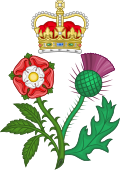Coat of arms of Great Britain
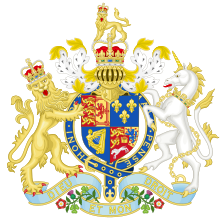
The Royal coat of arms of Great Britain was the coat of arms representing royal authority in the sovereign state of the Kingdom of Great Britain, in existence from 1707 to 1801. The kingdom came into being on 1 May 1707, with the political union of the kingdom of Scotland and the kingdom of England, which included Wales. With the 1706 Treaty of Union (ratified by the Acts of Union 1707), it was agreed to create a single kingdom, encompassing the whole of the island of Great Britain and its outlying islands, but not Ireland, which remained a separate realm under the newly created British crown.
On 1 January 1801, the royal arms of Great Britain were superseded by those of the United Kingdom of Great Britain and Ireland, when Great Britain was united with the Kingdom of Ireland by the Acts of Union of 1800 following the suppression of the Irish Rebellion of 1798.
Union of the Crowns and the Commonwealth
| The Union of the Crowns places England, Ireland and Scotland under one monarch | ||
| Arms | Dates | Details |
|---|---|---|
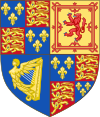 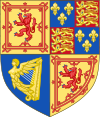 |
1603–1689 | James VI, King of Scots inherited the English and Irish thrones in 1603 (Union of the Crowns), and quartered the Royal Arms of England with those of Scotland. For the first time, the Royal Coat of Arms of Ireland was added to represent the Kingdom of Ireland.[1] (The Scottish version differs in giving the Scottish elements more precedence.) |
 |
1649–1654 |
These novel arms, already in use by parliamentarians in 1648, were adopted by the Commonwealth of England established in 1649.[2] |
 |
1654–1655 |
The Commonwealth of England, Scotland and Ireland (the Protectorate) was created in 1653. St Andrew's Cross was added to the arms in 1654.[3] |
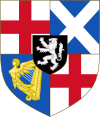 |
1655–1659 | The arms of the Commonwealth from 1655 to 1659. Struck in 1655, the Great Seal included the personal arms Oliver Cromwell on a shield in the centre.[1]
Blazon: Quarterly 1 and 4 Argent a Cross Gules (England) 2 Azure a Saltire Argent (Scotland) and 3 Azure a Harp Or Stringed Argent (Ireland) on an Inescutcheon Sable a Lion Rampant Argent (Cromwell's arms). The supporters were a crowned lion of England and a red dragon of Wales. The Scottish unicorn was removed, as it was associated with the Stuart Monarchy. The motto read PAX QUÆRITUR BELLO ("peace is obtained through war").[4] |
 |
1659–1660 |
Following the Protectorate, the 1654 arms were restored. |
  |
1603–1689 | Charles II restored the Royal Arms following the restoration after the civil wars. |
  |
1689–1694 | King James II & VII is deposed and replaced with his daughter Mary and her husband, William, Prince of Orange ruling jointly as William III & II and Mary II. As King and Queen Regnant they impaled their arms: William bore the Royal Arms with an escutcheon of Nassau (the royal house to which William belonged) added (a golden lion rampant on a blue field), while Mary bore the Royal Arms undifferenced.[5][6] |
 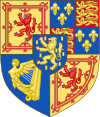 |
1694–1702 | After the death of Mary II, William III reigned alone, and used his arms only.[1][5] |
  |
1702–1707 | Queen Anne inherited the throne upon the death of King William III & II, and the Royal Arms returned to the 1603 version.[1] |
After the Acts of Union 1707
| Coats of arms of Great Britain | ||
| Arms | Dates | Details |
|---|---|---|
 |
1707–1714 | When the Acts of Union 1707 created the Kingdom of Great Britain (1707–1800), the Royal Arms of England and Scotland were impaled and moved to the first and fourth quarters, with the royal arms of France in the second quarter and the harp of Ireland in the third.[7] |
 |
1714–1800 | Following the death of Queen Anne, George I, previously Elector of Hanover inherited the throne under the provisions of the Act of Settlement 1701, and as a result the fourth quarter of the arms was changed to represent the new king's ancestry in Hanover: Brunswick–Lüneburg–Westphalia, surmounted by the Imperial Crown of the Holy Roman Empire for the Holy Roman office of Archtreasurer.[7] |
Notes
- ^ a b c d Brooke-Little, J.P., FSA (1978) [1950]. Boutell's Heraldry (Revised ed.). London: Frederick Warne LTD. pp. 205–222. ISBN 0-7232-2096-4.
{{cite book}}: CS1 maint: multiple names: authors list (link) - ^ Petchey, W.J., Massachusetts (1967). A Short Account of the Armorial Bearings of the Sovereigns of England. London: National Council of Social Service.
{{cite book}}: CS1 maint: multiple names: authors list (link) - ^ Scotland was formally reunited with England by an Ordinance of 12 April 1654 which ordered: "That the arms of Scotland viz: a Cross commonly called the St Andrew's Cross be received onto and borne from henceforth in the Arms of this Commonwealth ... etc". 'April 1654: An Ordinance for uniting Scotland into one Commonwealth with England.', Acts and Ordinances of the Interregnum, 1642–1660 (1911), pp. 871–875. URL: http://www.british-history.ac.uk/report.aspx?compid=56540&strquery=arms Date accessed: 1 January 2011.
- ^ Friar, Basic Heraldry (1993).
- ^ a b François Velde's Heraldica site
- ^ Arnaud Bunel's Héraldique européenne site
- ^ a b Brooke-Little, J. P. (1978) [1950]. Boutell's Heraldry (Revised ed.). London: Frederick Warne LTD. pp. 205–222. ISBN 0-7232-2096-4.
- National symbols of Great Britain
- Personal coats of arms
- British coats of arms
- National coats of arms
- Coats of arms with unicorns
- Coats of arms with chains
- Coats of arms with lions
- Coats of arms with crowns
- Coats of arms with fleurs de lis
- Coats of arms with harps
- Coats of arms with horses
- Coats of arms with roses
- Coats of arms with shamrocks
- Coats of arms with thistles
- Coats of arms with crosses

